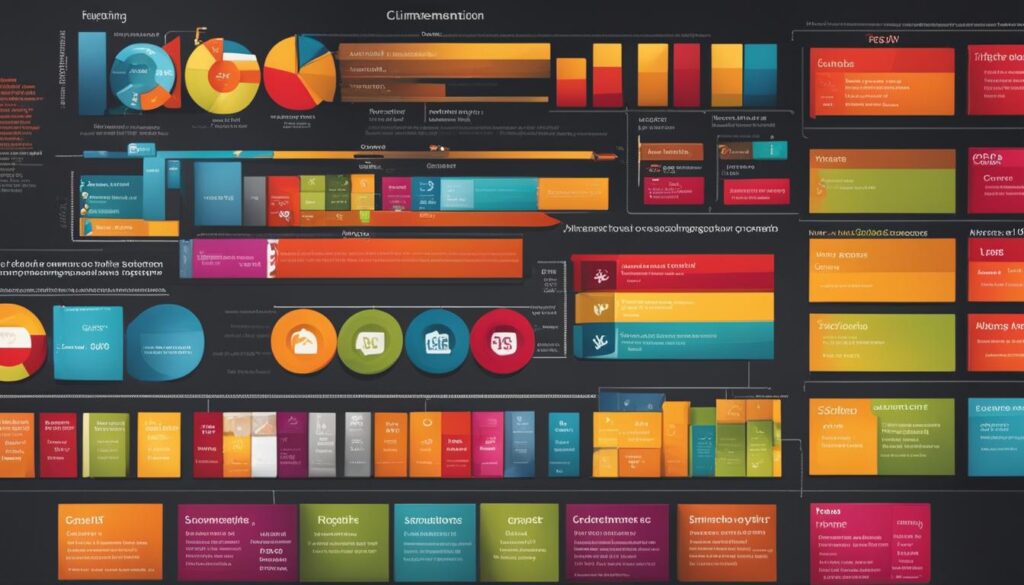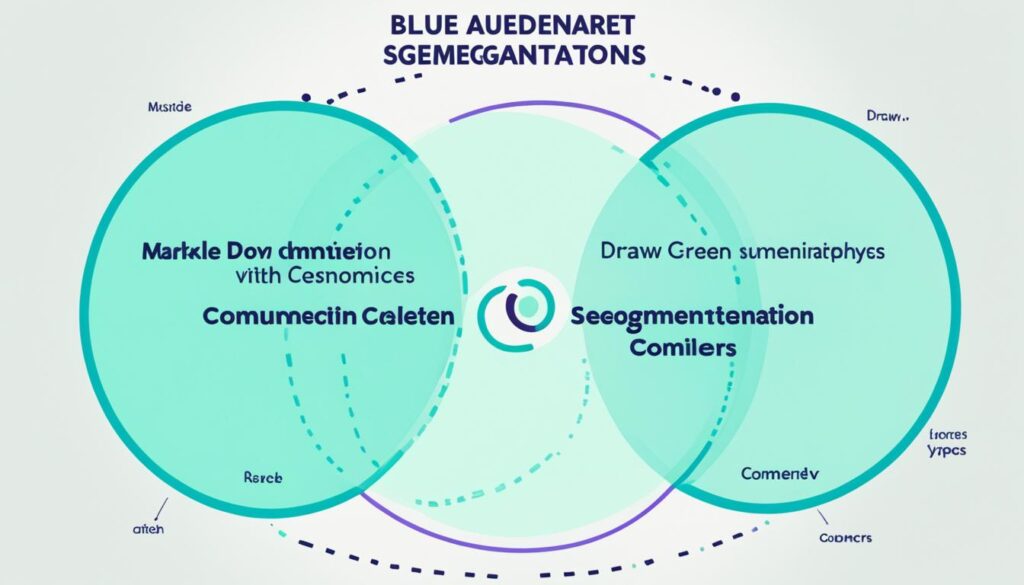Market segmentation is a powerful strategy used by businesses to enhance their marketing efforts. It involves dividing a broad target market into smaller, more manageable segments based on certain characteristics. This allows businesses to develop targeted marketing strategies that resonate with specific groups, resulting in improved communication, optimized resource allocation, and enhanced product development. By understanding the diverse needs and preferences of different market segments, businesses can connect with their audience on a deeper level and thrive in a competitive market.
Key Takeaways
- Market segmentation divides a broad target market into smaller segments based on specific characteristics.
- Segmentation strategies help businesses develop targeted marketing strategies that resonate with specific groups.
- Market segmentation allows for improved communication, optimized resource allocation, and enhanced product development.
- Understanding the diverse needs and preferences of different market segments helps businesses connect with their audience on a deeper level.
- Market segmentation is essential for businesses looking to thrive in a competitive market.
Understanding Market Segmentation
Market segmentation involves categorizing a diverse market into distinct groups with similar characteristics, needs, and behaviors. This segmentation can be based on various factors, including demographics, psychographics, geographic location, and behavioral patterns. By breaking down the market into manageable segments, businesses can develop targeted marketing strategies that resonate with specific groups instead of adopting a one-size-fits-all approach. This personalized approach allows for more effective communication and engagement with the audience.
Market segmentation is based on the premise that different groups of customers have unique characteristics and needs. By understanding these differences, businesses can tailor their marketing messages, products, and services to better meet the specific needs and preferences of each segment. For example, a clothing retailer may segment its market based on age groups, targeting the younger segment with trendy styles and the older segment with classic designs.
Behavioral patterns also play a crucial role in market segmentation. By analyzing customers’ purchasing habits, brand loyalty, and usage behavior, businesses can identify distinct segments and develop targeted marketing strategies. For instance, a fitness equipment manufacturer may segment its market based on customers’ workout behaviors, targeting gym enthusiasts with high-intensity equipment and home exercisers with compact and user-friendly products.
Market segmentation allows businesses to move away from a generic marketing approach and focus their resources on specific customer segments. Through targeted marketing efforts, businesses can communicate more effectively with customers, build stronger relationships, and motivate them to take desired actions.
Market segmentation variables can vary depending on the industry and specific business objectives. Here are some commonly used segmentation variables:
- Demographics: Age, gender, income, occupation, education, marital status, etc.
- Psychographics: Personality traits, values, attitudes, interests, lifestyle, etc.
- Geographic: Country, region, city, climate, population density, etc.
- Behavioral: Purchasing behavior, usage frequency, brand loyalty, customer satisfaction, etc.

| Segment | Characteristics | Needs | Behaviors |
|---|---|---|---|
| Segment A | Age: 18-24 Gender: Male Income: $40,000-$60,000 |
Desire for trendy clothing Affordability Preference for convenience |
Frequent online shopping Regularly follows fashion influencers Seeks discounts and promotions |
| Segment B | Age: 35-44 Gender: Female Income: $60,000-$80,000 |
Preference for high-quality clothing Comfort and durability Timeless styles |
Prefers in-store shopping Seeks personalized customer service Values brand reputation |
Benefits of Market Segmentation
Market segmentation offers numerous benefits to businesses, enabling them to optimize their marketing strategies for greater success. By tailoring communication strategies to the unique preferences and characteristics of each segment, businesses can foster personalized communication and establish a stronger connection with their target audience. This personalized approach not only increases engagement but also enhances customer retention.
One of the key advantages of market segmentation is the optimized allocation of resources. By focusing on segments that offer the highest potential for growth and profitability, businesses can allocate their marketing budget and efforts more effectively. This ensures that resources are utilized in the most efficient way, maximizing the return on investment.
Furthermore, market segmentation plays a crucial role in improving product development. By understanding the specific needs and preferences of different market segments, businesses can tailor their product offerings to better meet customer demands. This leads to improved product development, resulting in enhanced customer satisfaction and loyalty.
Another significant benefit of market segmentation is its adaptability to market changes. Businesses that regularly reassess and adjust their strategies based on market trends and customer insights are more likely to stay agile and responsive to changing market conditions. This adaptability allows businesses to seize new opportunities and mitigate risks effectively.
“Market segmentation enables personalized communication, optimized resource allocation, improved product development, enhanced customer retention, and adaptability to market changes.”

Benefits of Market Segmentation
| Benefits | Description |
|---|---|
| Personalized Communication | Targeted messaging and communication tailored to specific segments, fostering stronger connections and increasing engagement. |
| Optimized Resource Allocation | Effective allocation of marketing resources to segments that offer the highest potential for growth and profitability. |
| Improved Product Development | Understanding segment needs and preferences to guide product development, resulting in enhanced customer satisfaction and loyalty. |
| Enhanced Customer Retention | Building stronger relationships with customers, leading to improved customer retention and loyalty. |
| Adaptability to Market Changes | Regularly reassessing and adjusting strategies to stay agile and responsive to market trends and dynamics. |
Market Segmentation vs. Audience Segmentation
Market segmentation and audience segmentation are two closely related concepts that play a crucial role in marketing strategies. While both approaches aim to divide a broad target market into smaller, more manageable segments, they differ in their focus and criteria. Let’s dive deeper into the relationship between market segmentation and audience segmentation to understand how businesses can effectively connect with their target customers.
Market Segmentation: Understanding the Diversity Within a Market
Market segmentation involves dividing a broad market into distinct groups based on various characteristics, such as demographics, psychographics, geographic location, and behavioral patterns. This process helps businesses gain a deeper understanding of the diverse needs, preferences, and behaviors of different market segments. By identifying and analyzing these segments, businesses can develop targeted marketing strategies that resonate with specific groups, leading to improved communication, optimized resource allocation, and enhanced product development.
Let’s consider an example to illustrate this point. A global smartphone manufacturer may use market segmentation to identify segments of customers who prefer high-end, cutting-edge features and are willing to pay a premium, and another segment that values affordability and practicality. By developing and marketing different product lines to these distinct segments, the company can cater to their specific needs and preferences, leading to enhanced customer satisfaction and increased sales.
Audience Segmentation: Refining Market Segments for Targeted Engagement
While market segmentation provides a foundation for understanding the diversity within a market, audience segmentation takes it a step further by refining these segments based on communication preferences, media consumption habits, or specific interests. Audience segmentation helps businesses understand how to effectively engage with their target customers by tailoring their marketing strategies to the unique preferences and behaviors of each segment.
For instance, a cosmetics company that has identified a segment of environmentally-conscious consumers through market segmentation can further refine this segment using audience segmentation. By understanding their preferred communication channels, such as social media platforms or eco-friendly events, the company can create targeted marketing campaigns that resonate specifically with this audience. This level of customization allows businesses to establish a deeper connection with their customers and increase the chances of converting them into loyal brand advocates.
Understanding the Relationship: Leveraging Market Segmentation for Audience Segmentation
Market segmentation serves as the foundation for audience segmentation. By first identifying distinct market segments through market segmentation, businesses can gain a better understanding of the diversity within their target market. This initial framework helps businesses identify specific customer groups and their unique characteristics.
For example, let’s consider a fitness brand that has conducted market segmentation and identified segments of health-conscious individuals and fitness enthusiasts. Using this information, they can further refine these segments through audience segmentation, considering factors like preferred workout activities, fitness goals, or preferred social media platforms. This refined understanding allows the brand to tailor their marketing messages and campaigns to each specific audience segment, increasing their chances of attracting and retaining customers.
In essence, market segmentation and audience segmentation are interdependent. While market segmentation lays the foundation by dividing a broad market into distinct groups based on various characteristics, audience segmentation refines these segments by considering additional criteria that help businesses effectively engage with their target customers. By leveraging the relationship between market segmentation and audience segmentation, businesses can develop targeted marketing strategies that resonate with specific customer groups, resulting in enhanced customer satisfaction and increased business success.

Key Takeaways:
- Market segmentation involves dividing a broad market into distinct groups based on various characteristics.
- Audience segmentation refines these segments based on communication preferences and specific interests.
- Market segmentation provides the foundation for audience segmentation, enabling businesses to better understand and target specific customer groups.
- By leveraging the relationship between market segmentation and audience segmentation, businesses can develop targeted marketing strategies that resonate with their target customers.
Key Factors for Audience Segmentation
Audience segmentation plays a crucial role in creating targeted marketing campaigns that resonate with specific customer groups. By understanding the key factors that drive audience segmentation, businesses can gain valuable insights into customer needs and preferences. Three primary factors that businesses consider for audience segmentation are:
- Demographic Segmentation: This segmentation approach focuses on objective criteria, such as age, gender, income, and location. By categorizing customers based on these demographic factors, businesses can personalize their messaging and tailor marketing strategies to specific target audiences. For example, a fashion retailer may create separate campaigns for young adults and middle-aged customers, offering products that align with their unique needs and preferences.
- Psychographic Segmentation: Unlike demographic segmentation, psychographic segmentation delves deeper into customers’ values, attitudes, interests, and lifestyles. By understanding the psychological makeup of different customer segments, businesses can create more personalized and emotionally resonant marketing messages. For instance, a fitness brand might target health-conscious individuals who value holistic wellness and environmentally-friendly practices.
- Behavioral Segmentation: Behavioral segmentation analyzes customers’ purchasing patterns, brand loyalty, and usage behavior. By studying how customers interact with a brand, businesses can identify specific behavioral patterns and create targeted marketing strategies. For example, an e-commerce platform may segment customers based on their past purchase history, offering personalized recommendations and exclusive discounts to frequent buyers.
By leveraging these key factors in audience segmentation, businesses can gain a better understanding of their customers’ unique characteristics and preferences. This knowledge enables them to develop tailored marketing strategies that resonate with each specific segment, leading to increased customer engagement, improved conversion rates, and greater overall business success.

Approaches to Audience Segmentation
When it comes to audience segmentation, businesses can employ various approaches to gain a deeper understanding of their customers. Here, we explore traditional segmentation methods, advanced segmentation techniques, and the impact of customer segmentation in the digital age.
Traditional Segmentation Methods
Traditional segmentation methods have long been used to divide the market into distinct customer groups. These methods include:
- Geographical segmentation: Segmenting customers based on their location helps businesses tailor their marketing efforts to specific regions or areas.
- Demographic segmentation: Dividing customers based on demographic characteristics such as age, gender, income, and education level allows businesses to target specific groups with customized messaging.
- Psychographic segmentation: This method focuses on customers’ values, attitudes, interests, and lifestyles, enabling businesses to create targeted campaigns that resonate with the unique preferences of each segment.
Traditional segmentation methods remain valuable in providing basic insights into customer groups. However, businesses need to adopt more advanced techniques to unlock deeper insights.
Advanced Segmentation Techniques
To gain more nuanced insights into customer behavior, businesses can utilize advanced segmentation techniques. These techniques go beyond traditional methods and leverage data analytics to uncover valuable insights. Some advanced segmentation techniques include:
- Predictive modeling: By utilizing historical data and statistical models, businesses can predict customer behavior and better understand which segments are likely to respond positively to specific marketing campaigns or offers.
- Social media analysis: With the prevalence of social media platforms, businesses can gather data on customer preferences, interests, and interactions. This data can be used to segment customers based on their social media behavior and tailor campaigns accordingly.
Advanced segmentation techniques empower businesses to uncover hidden patterns and better anticipate customer needs, ultimately leading to more efficient marketing strategies.
Customer Segmentation in the Digital Age
In the digital age, customer segmentation has evolved even further, thanks to the availability of big data and analytics. Businesses can leverage these technologies to gain a comprehensive understanding of their audience and personalize their marketing efforts. The digital age allows for:
- Real-time personalization: By tracking customer behavior in real-time, businesses can provide personalized experiences and targeted content, increasing customer engagement and satisfaction.
- Dynamic segmentation: Instead of relying on static segments, businesses can now create dynamically changing segments based on real-time data. This allows for more agility and adaptability in marketing strategies.
Customer segmentation in the digital age enables businesses to connect with their audience on a deeper level, offering personalized experiences that resonate with individual needs and preferences.
Summary
By combining traditional segmentation methods with advanced techniques and embracing customer segmentation in the digital age, businesses can truly understand their audience and develop tailored marketing strategies. The ability to personalize marketing efforts based on real-time data and insights empowers businesses to engage customers on a deeper level, leading to increased customer satisfaction and business success.
Customer Segmentation Examples: Real-World Applications
Customer segmentation is a powerful strategy that can be applied across various industries to personalize marketing strategies and enhance customer satisfaction. Different segmentation techniques such as geographic segmentation, psychographic segmentation, and behavioral segmentation can be utilized to target specific customer segments and deliver tailored messaging. Let’s explore some real-world examples of customer segmentation in action:
Geographic Segmentation: Tailoring Marketing Campaigns to Regional Preferences
One example of geographic segmentation in action is a multinational beverage company that tailors its marketing campaigns based on the preferences and cultural nuances of different regions. By analyzing data on customer preferences and behaviors in specific geographical areas, the company can create targeted marketing strategies that resonate with the local audience.
For instance, a soft drink brand might adapt its flavors or packaging to align with regional tastes, ensuring that their products appeal to the unique preferences of customers in different locations. This personalized approach allows the company to better connect with its target audience, driving engagement and increasing market share in specific regions.
Psychographic Segmentation: Targeting Customer Segments based on Lifestyles and Values
| Luxury Fashion Brand | Customer Segment | Messaging and Marketing Strategy |
|---|---|---|
| Brand A | Young professionals who value sustainability and ethical fashion | Messaging focuses on the brand’s eco-friendly practices and use of sustainable materials. Marketing efforts include collaborations with environmental organizations and influencers promoting conscious consumerism. |
| Brand B | Sophisticated and affluent customers who appreciate timeless elegance | Messaging showcases the brand’s classic designs, impeccable craftsmanship, and exclusivity. Marketing efforts include luxury events, partnerships with high-end hotels, and targeted advertising in elite fashion publications. |
Pychographic segmentation enables luxury fashion brands to target different customer segments with distinct messaging based on their lifestyles and values. By understanding the aspirations, attitudes, and interests of specific customer groups, brands can develop marketing strategies that resonate with their target audience on a deeper level.
Behavioral Segmentation: Identifying Customer Buying Patterns for Targeted Marketing
“Understanding customer behavior and preferences is vital in today’s digital age. Behavioral segmentation allows businesses to identify different types of customers based on their purchasing patterns, brand loyalty, and usage behavior.”
An e-commerce retailer can leverage behavioral segmentation to categorize customers into segments such as frequent buyers, occasional shoppers, and one-time purchasers. By analyzing data on customer behavior, including purchase history, browsing patterns, and engagement with marketing campaigns, the retailer can develop targeted marketing efforts to increase customer retention and drive repeat purchases.
For instance, the retailer might send personalized recommendations to frequent buyers, offer exclusive discounts to occasional shoppers, and re-engage one-time purchasers with relevant product promotions. This tailored approach based on behavioral segmentation enhances customer satisfaction and boosts overall sales.
These examples highlight the practical applications of customer segmentation in various industries. By effectively implementing geographic segmentation, psychographic segmentation, and behavioral segmentation, businesses can create targeted marketing strategies that align with the diverse needs and preferences of their customers, ultimately leading to increased customer satisfaction and business success.
Conclusion
Market segmentation is a vital tool in today’s modern marketing strategy, empowering businesses to deliver personalized experiences that resonate with their target audience. By understanding the diverse needs and preferences of different market segments, businesses can develop highly targeted marketing campaigns that maximize communication effectiveness and drive customer engagement.
One of the key advantages of market segmentation is the ability to create personalized communication that speaks directly to the unique characteristics of each segment. This tailored approach allows businesses to deliver relevant content, products, and services, fostering a stronger connection with their audience and increasing customer satisfaction.
Furthermore, market segmentation enables optimized resource allocation. By identifying and prioritizing segments with the highest growth potential and profitability, businesses can allocate their marketing resources more efficiently, resulting in a higher return on investment.
In today’s digital era, where competition is fierce, market segmentation is essential for success. By recognizing the importance of understanding their target audience on a deeper level, businesses can unlock the full potential of their marketing strategy. With market segmentation as a guiding principle, businesses can thrive, delivering personalized experiences that meet individual customer needs and preferences, ultimately driving business growth and ensuring a competitive edge.
FAQ
What is market segmentation?
Market segmentation is the strategy of dividing a broad target market into smaller, more manageable segments based on certain characteristics.
Why is market segmentation important?
Market segmentation allows businesses to develop targeted marketing strategies that resonate with specific groups, resulting in improved communication, optimized resource allocation, and enhanced product development.
What factors can be used for market segmentation?
Market segmentation can be based on various factors, including demographics, psychographics, geographic location, and behavioral patterns.
What are the benefits of market segmentation?
Market segmentation offers benefits such as personalized communication, optimized resource allocation, improved product development, enhanced customer retention, and adaptability to market changes.
How does market segmentation differ from audience segmentation?
Market segmentation involves dividing a broad market into distinct groups, while audience segmentation refines these segments based on communication preferences, media consumption habits, or specific interests.
What are the key factors for audience segmentation?
Key factors for audience segmentation include demographic segmentation, psychographic segmentation, and behavioral segmentation.
What are the different approaches to audience segmentation?
Different approaches to audience segmentation include traditional methods such as geographical, demographic, and psychographic segmentation, as well as advanced techniques like predictive modeling and social media analysis.
How can customer segmentation be applied in different industries?
Customer segmentation can be applied in various industries, such as tailoring marketing campaigns to different regions, targeting different customer segments with distinct messaging, and identifying frequent buyers for targeted marketing efforts.
What is the significance of market segmentation in modern marketing?
Market segmentation empowers businesses to connect with their audience on a deeper level, deliver personalized experiences, and thrive in today’s competitive business landscape.








